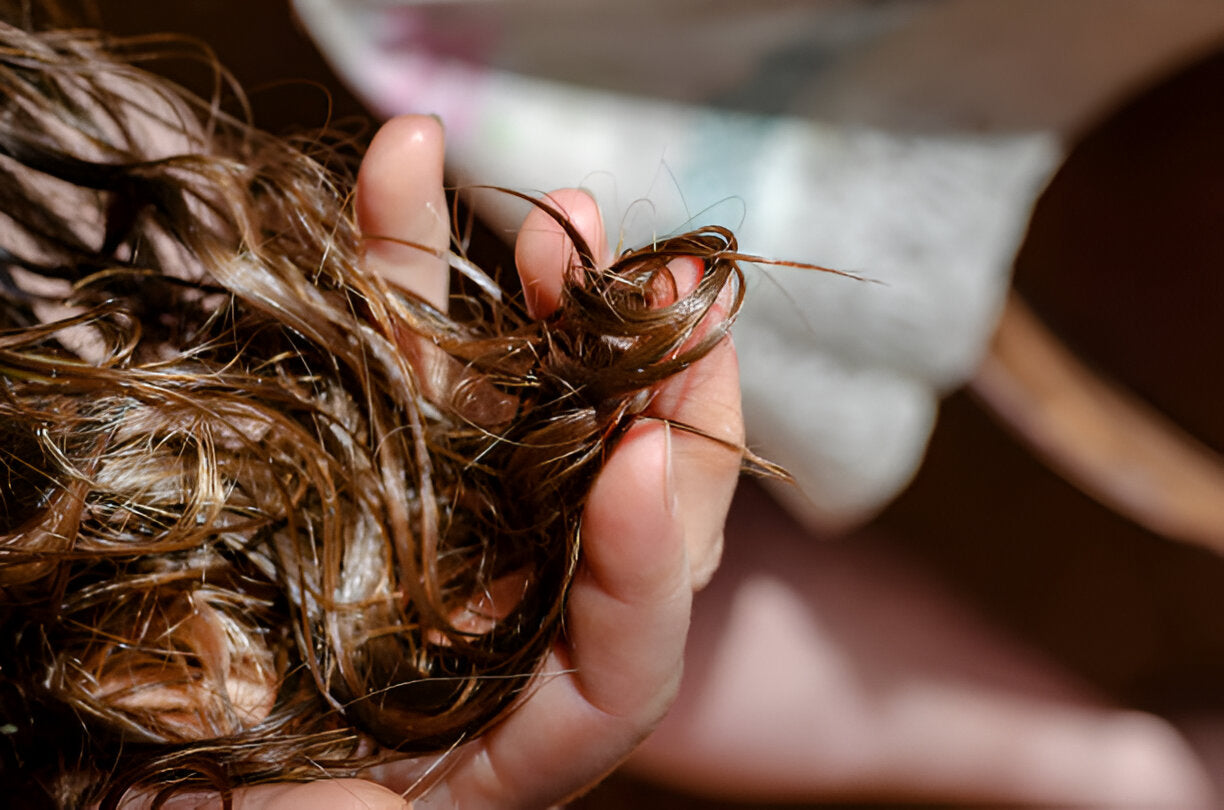When considering wig maintenance, a common question arises: Can wigs get lice? It's essential to address this concern thoroughly to ensure your wig remains clean and hygienic. Let's investigate whether wigs can get lice and explore practical ways to prevent any issues.
Can Wigs Get Lice? A Perfect Guide
Wigs often lead to concerns about whether lice can transfer from human hair to a wig. While lice can come into contact with a wig, it is quite rare for them to survive or thrive on it. Lice are parasites that need human hair's warm, moist environment to live and reproduce. They feed on blood from the scalp, and wigs—whether made from synthetic fibers or processed human hair—do not provide this necessary environment. Thus, even if lice land on a wig, they are unlikely to continue living or reproducing there.
Why Lice Might End Up on a Wig
Lice are usually spread through direct contact between heads, making it possible, though not common, for lice to transfer to a wig if someone with lice uses it. However, just because lice might land on a wig doesn't mean they will thrive. Wigs do not offer the warmth and moisture lice need to live. The conditions on a wig are not suitable for lice to reproduce or sustain themselves, which means they are unlikely to pose a persistent problem.
How Lice in Human Hair Differ from Lice on Wigs?
Lice are specifically adapted to live on human hair. They require the warmth and moisture of the scalp to survive. They feed on blood and lay their eggs close to the scalp. In contrast, wigs made from synthetic fibers or natural hair do not provide the same conditions. Without the warmth and moisture of a human scalp, lice cannot survive or reproduce on a wig, even if they come into contact with it.
Can Nits Survive Outside of Hair?
Nits are the eggs laid by lice attached to the hair shafts near the scalp. They need the specific conditions of a human scalp—warmth and moisture—to survive and develop. Outside of this environment, nits cannot survive for long. Nits are unlikely to develop into adult lice on a wig, which lacks the necessary conditions for hatching. Therefore, even if you find nits on a wig, they cannot hatch or grow into lice.
Lace Wigs and Bugs: What You Need to Know
Lace wigs are popular due to their natural look and breathable lace base. Concerns may arise about whether lace wigs can harbor bugs, including lice. Lace wigs, however, are not conducive environments for lice. The breathable lace and materials used do not support lice survival or reproduction. While bugs like lice might occasionally come into contact with lace wigs, they are not likely to persist or cause problems.
Maintaining and Cleaning Lace Wigs to Prevent Bug Infestations
Regular cleaning and appropriate storage are essential to ensure that lace wigs remain free from pests like lice and insects. Proper maintenance helps extend the wig's lifespan and maintain its overall condition.

Regular Cleaning for Lace Wigs
Regular cleaning involves washing your lace wig according to the manufacturer's instructions. This is crucial for removing dirt, oils, and potential contaminants that might attract bugs. A consistent cleaning routine using a mild, wig-friendly shampoo and conditioner helps preserve the wig's materials and keeps it hygienic. Regular washing ensures the wig remains fresh and free from any pest or buildup that could affect its quality.
Proper Storage of Lace Wigs
Proper storage refers to keeping your lace wig in an appropriate environment to prevent any potential bug infestations. Storing the wig in a clean, dry place helps to avoid exposure to dust and insects that could cause problems. Using a storage box or bag specifically designed for wigs provides extra protection and maintains the wig's shape and quality. Proper storage minimizes the risk of infestations and helps keep the wig in excellent condition.
Let's now explore more about [Make wigs look real] in more detail.
Wig Head Bugs and How to Prevent Infestations
This section addresses the issue of small insects that might be found on wigs and guides preventing such infestations. It differentiates between lice and other bugs and offers strategies for keeping wigs pest-free.
What Bugs Might Be Found on Wigs
We discuss the types of small insects that could potentially appear on wigs. While lice are not commonly found on wigs, other pests like dust mites or tiny beetles might occasionally be present. These insects are generally different from lice and usually do not pose the same risks. Understanding the types of pests that could be present helps in taking appropriate measures to manage them effectively.
How to Prevent Bugs from Infesting Your Wig
Keeping your wig in a clean, controlled environment helps reduce the risk of bugs. Using a wig stand when the wig is not in use prevents it from coming into contact with dust and insects. These preventive measures ensure that your wig remains clean and free from unwanted pests.
Best Practices for Storing Wigs
This section highlights the best practices for storing wigs to maintain their cleanliness and quality. Proper storage techniques are crucial for avoiding issues with bugs and preserving the wig's appearance.
Clean the Wig Before Storing
Before putting your wig away, make sure it is thoroughly cleaned according to the manufacturer's instructions. This helps remove any dirt, oils, or residue that could attract pests or cause damage. Use a mild wig shampoo and conditioner to keep the fibers in good condition and prevent buildup.
Use a Wig Stand
Place your wig on a wig stand when not in use. This helps preserve the wig’s shape and prevents it from becoming misshapen or tangled. A wig stand also allows for better air circulation, which helps keep the wig fresh and reduces the risk of mold or mildew.
Store in a Dry, Clean Place
Store your wig in a clean, dry location to avoid exposure to dust and potential insects. A dedicated wig storage box or bag can provide extra protection and keep the wig in optimal condition. Avoid placing the wig in areas with high humidity or temperature fluctuations, as these conditions can damage the fibers over time.
Avoid Direct Sunlight and Humidity
Store your wig in a place where it will not be exposed to direct sunlight, as UV rays can cause fading and damage to the wig fibers. Additionally, avoid high-humidity areas, as excessive moisture can lead to mold or mildew growth, compromising the wig’s quality.
Adequate wig storage involves specific actions to ensure your wig remains in optimal condition. Cleaning the wig before storing it removes any dirt or product buildup that could attract pests. Using a wig stand helps maintain the wig's shape and prevents it from becoming misshapen. Storing the wig in a dry, clean place reduces exposure to dust and potential insects. These practices are essential for keeping the wig in excellent condition and preventing any issues with bugs.
How Long Can You Wear a Toupee
This section provides information on the duration of a toupee's wear and offers guidelines for its maintenance and wear. Proper care and regular breaks are important for both the toupee and scalp health.

Let's now explore more about [synthetic Blonde wigs] in more detail.
Guidelines for Wearing a Toupee
Adhering to the care instructions provided with the wig helps maintain its cleanliness and condition. It is also essential to remove the toupee periodically to allow your scalp to breathe, which prevents discomfort and potential scalp issues from prolonged wear. Following these guidelines helps maintain both the toupee and your scalp health.
FAQs About Wigs and Lice
Here are some frequently asked questions about wigs and lice, along with straightforward answers to help clarify common concerns:
Can lice survive on synthetic wigs?
Lice cannot survive on synthetic wigs because they need the warmth and moisture of human hair to thrive. Synthetic materials do not provide the environment for lice to live or reproduce.
What should I do if I find lice on my wig?
If you find lice on your wig, wash it thoroughly according to the care instructions. You should also seek advice from a professional to ensure the wig is properly treated and cleaned.
How can I prevent lice from getting on my wig?
To prevent lice from getting on your wig, maintain good hygiene for both the wig and your hair. Store the wig in a clean, controlled environment to reduce the risk of lice or other pests.
Can lice survive on a wig if I had lice recently?
If you recently had lice, they might temporarily be present on a wig, but they will not survive long without a human scalp. Proper cleaning of the wig will help eliminate any remaining lice.
What is the best way to clean a wig to remove lice?
The best way to clean a wig to remove lice is to follow the manufacturer's instructions carefully. If necessary, use lice treatment products, and ensure the wig is thoroughly washed and dried to eliminate any pests.
Conclusion
In summary, while lice can come into contact with a wig, they are unlikely to survive or thrive on it. Whether synthetic or made from processed human hair, wigs do not provide the conditions for lice to live or reproduce. By adhering to proper cleaning and storage practices, you can effectively manage and prevent any potential issues with lice. So, can wigs get lice? Maintaining good hygiene and care for your wig will help ensure it remains free from these pests.


